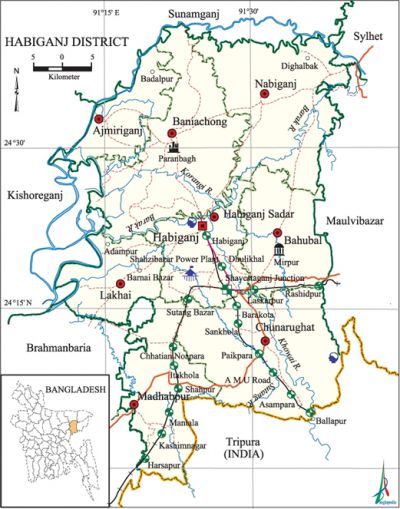Habiganj District
Habiganj District (sylhet division) area 2574.7 sq km, located in between 23°58' and 24°42' north latitudes and in between 91°09' and 91°40' east longitudes. It is bounded by sunamganj district on the north, tripura state of India on the south, maulvibazar and sylhet districts on the east, brahmanbaria and kishoreganj districts on the west.
Population Total 2023603; male 993405, female 1030198; Muslim 1670610, Hindu 347668, Buddhist 62, Christian 2302 and others 2774. Indigenous communities such as khasia and manipuri belong to this upazila.
Water bodies kushiyara, Kalni, khowai, Sutang, Korangi, barak river are notable.
Administration Habiganj Sub Division was established in 1874 and it was turned into a district in 1984.
| District | |||||||||
| Area (sq km) | Upazila | Municipality | Union | Mouza | Village | Population | Density (per sq km) | Literacy rate (%) | |
| Urban | Rural | ||||||||
| 2574.7 | 8 | 5 | 75 | 1127 | 2120 | 235527 | 1801951 | 786 | 40.5 |
| Others Information of District | ||||||||
|
Name of Upazila |
Area |
Municipality |
Union |
Mouza |
Village |
Population |
Density |
Literacy rate (%) |
| Ajmiriganj | 223.98 | 1 | 5 | 66 | 133 | 114265 | 510 | 37.1 |
| Chunarughat | 495.50 | 1 | 10 | 159 | 373 | 302110 | 610 | 40.8 |
| Nabiganj | 439.61 | 1 | 13 | 203 | 356 | 345179 | 785 | 41.0 |
| Baniachong | 482.26 | - | 15 | 237 | 359 | 332530 | 690 | 34.7 |
| Bahubal | 250.65 | - | 7 | 140 | 342 | 197997 | 790 | 39.8 |
| Madhabpur | 294.28 | 1 | 11 | 176 | 267 | 319016 | 1084 | 39.8 |
| Lakhai | 196.54 | - | 6 | 52 | 65 | 148811 | 757 | 33.7 |
| Habiganj Sadar | 191.88 | 1 | 8 | 94 | 225 | 263695 | 1374 | 50.7 |
Source Bangladesh Population Census 2011, Bangladesh Bureau of Statistics.

War of Liberation On 4 April 1971 Col. mohammad ataul ghani osmany (supreme commander of the war of liberation) and some officers of the 2nd and 4th East Bengal Regiment assembled in the Teliapara Tea Garden Dakbungalow to discuss the war situation. On 16 November, an encounter was held between the freedom fighters and the Pak army at Ajmiriganj upazila in which Jagat Jyoti was killed. The Pak army killed 11 villagers of the upazila. There is a mass grave at Nabiganj and 3 mass killing sites (at Madhabpur, Chunarughat and Baniachong); 3 memorial monuments had been built at Nabiganj, Madhabpur and Chunarughat.
Literacy rate and educational institutions Average literacy 40.5%; male 42.2%, female 38.9%. Educational institutions: college 19, primary training institute 1, technical college 1, secondary school 155, primary school 885, community school 2, kindergarten 17, madrasa 140. Noted educational institutions: Habiganj Government Bindaban College, Paniumda Ragib-Rabeya School and College, Alif Sobhan College, Gobindapur Government High School (1832), Habiganj Government High School (1843), Rajar Bazar Government High School (1867), Jalsukh Krishna Govinda Public High School (1876), Mirashi High School (1887), Fakirabad Government High School (1890), LR Government High School (1896), Adaoir Lokenath High School (1911), Habiganj High School (1913), Nabiganj JK High School (1916), Shayestaganj High School (1918), Chhatian Bishwanath High School (1921), Dinarpur High School (1921), BKGC Government Girls' High School (1923), GK and HK High School (1924), Jagadishpur JC High School (1924), Dakshina Charan Pilot High School (1928), Laskarpur Primary School (1843), Habiganj Government Primary School (1883), Ubahata Kudratia Dakhil Madrasa (1870), Mirpur Dakhil Madrasa (1920), Shankhola Dakhil Madrasa (1928), Shayestaganj Kamil Madrasa, Habiganj Daruchchhunnat Senior Madrasa.
Main sources of income Agriculture 61.13%, non-agricultural labourer 7.20%, industry 2.25%, commerce 10.95%, transport and communication 1.98%, service 4.58%, construction 1.13%, religious service 0.39%, rent and remittance 1.80% and others 8.59%.
Newspapers and periodicals Daily: Swadesh Barta, Khowai, Habiganj Samachar, Pravakar, Pratidener Bani, Ajker Habiganj, Bibiana; weekly: Swadhikar, Janatar Dalil, Swadeshbarta, Tarapbart, Drishtikon, Khowai, Hobiganj Samachar; defunct: monthly Moitri (1909), weekly Projapati (1909), Sree Sree Sonar Gauranga (BS 1329), Palli Bani (1940), weekly Shahid (1948), weekly Jagaran (1955), monthly Avijatrik (1966).
Folk culture Various kinds of spritual songs such as Fakirali song, Marshia songs are sung on the occasion of Urs in different mazars. Sarigan is sung in the district on the occasion of boat race during the rainy season. Besides, most notable folk songs include Dhamail song and dance, Gazir Geet, Kirtan, Brata song, Pala, Holi (mostly performed by the tea garden workers) and Jari gan.
Important installations or tourist spots Sultanshi Habeli built by the great poet Syed Sultan at Habiganj Sadar upazila, Bibiana Gas Field (Nabiganj), Shahjibazar Power Plant (Madhabpur, Baniachong Rajbari, ancient dighi of Syed Gaous (R) at Mashajan (Habiganj Sadar), Sagardighi (Baniachong), Tea garden in Madhabpur Upazila. [Jayanta Sing Roy]
See also The upazilas under this district.
References Bangladesh Population Census 2001 and 2011, Bangladesh Bureau of Statistics; Cultural survey report of Habiganj District 2007; Cultural survey report of upazilas of Habiganj District 2007.
